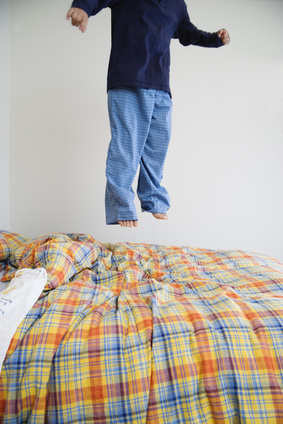This post is one in a series designed to help you get out of the house and enjoy life with your child. Previously we described how to deal with anxiety and disruptive behaviors, so as to overcome these before moving on to outside excursions. Here we talk about sleep. Sleep is essential to a happy life with your child. If the family is not sleeping it is very difficult to manage anything else.
As autism parents we may find ourselves
- Lying down with a child for hours to get him to sleep,
- bringing him into our own bed,
- taking the child to another bed or room in the house,
- dealing with the problem all over again during the inevitable night-time wake-ups.
We know what it is like to struggle with sleep problems for four to eight hours. It’s exhausting, agonizing and depressing.
My family dealt with those problems for years. When I learned about TAGteach, I was able to teach my son to lie still, be quiet, and go to sleep.
I’ll be honest. This took some time. It was hard work, and I often felt depressed and resentful. But eventually, my son learned to sleep. This is a step by step process that will take some time, but if you don’t start it now, you will still not be sleeping weeks and months from now. It is worth the effort to take baby steps toward sleep and reap the rewards for years to come.
Thanks to this systematic approach, now we sleep and we are much happier.
Let’s see how to tackle the sleep problem with the always useful, effective and flexible TAGteach approach.
First things first – Consistent Routine
The following steps are always recommended for sleep problems:
- Set a consistent wake-up time early in the morning
- Set a consistent bedtime in the evening
- Limit screen time before bedtime
- Avoid large meals or snacks late in the evening.
Next things next — The Sleep Tag Points
Set the following tag points (click here to find out what a tag point is) to reinforce to teach quiet nighttime behaviors:
- Gets in Bed
- Quiet Mouth
- Hands Still
- Feet Still
- Head on Pillow
- Yawns
- Exhales
For tagging Sleep Tag Points, use a small flashlight, not a tagger. The flash of light will mark the desired behavior just as effectively as a tagger. Plus, the flashlight is quiet so you won’t disturb the rest of the family with the sound of a tagger. It doesn’t have to be a big bright flashlight, a dim flicker of light is fine. It’s also helpful to have a comfortable high stool for outside the bedroom, and a comfortable chair (preferably a swivel chair) for inside the bedroom.
There are two ways to reinforce these desired behaviors: from outside the room or from inside the room. I started out by reinforcing from outside the room, but later realized that I could also reinforce from inside the room.
Reinforce Sleep Tag Points From Outside the Room
Armed with your flashlight, sit outside the bedroom on your stool, with the bedroom door slightly ajar so you can observe your child. Wait and look for every possible chance to tag and reinforce one of the sleep tag points listed above.
When your child has a split second of Quiet Mouth or Still Body Part, flash the light (away from the child’s face), go in and give your child a gentle pat on the shoulder or arm. Don’t talk or explain, just pat and leave immediately. Go back outside and wait for the next instance of Quiet Mouth, Still Body Part, Head On Pillow or Yawns. These moments will happen, but may be brief. Keep reinforcing them with a flash of light and gentle pat. This may take a long time, but eventually your child will relax, lie still and fall asleep.
To review:
- Flash the light, go in the room and pat child’s arm every single time he is quiet or still
- Do not go in if he is screaming or jumping, no matter how loud he sounds
- If the child bolts from the room, take him by the hand and gently lead him back to the bed
- If he gets in the bed fine, if not, return to your stool, wait for him to do any one of the Sleep Tag Points listed above
- Continue flashing the light and rewarding him with your presence and attention when he performs one of the Sleep Tag Points
Keep this up until the child calms down. This may take some time, especially the first few weeks.
Working from outside the room may be better if your child is doing a lot of bolting out of the room, or jumping around in the bedroom. Once he is more settled inside the bedroom and staying in bed more, you may wish to start reinforcing from inside the room, as described below.
If your child is already staying in his room, you can start by working from inside the room. Experiment to see which works best for your situation, and be prepared to adapt as necessary.
Reinforce Sleep Tag Points From Inside the Room
Sit in the swivel chair near the bed. Do the flash/pat routine every time your child performs one of the Sleep Tag Points. Face away from him if he makes noise or moves, but face toward him to pat his arm when he is quiet or still. The swivel chair makes it easy to swivel toward your child when he is quiet or still, and to swivel away when he makes noises or bounces around.
When you sit right next to him, you can reinforce Quiet Mouth and Arms/Legs Still, Head on Pillow or Yawns almost continuously. This intensive stream of reinforcement helped my son calm down more quickly, and he fell asleep in less time than it took when I stayed outside the door.
Teaching my son to sleep was an adventure with both laughter and many moments of frustration, but we ended up with a good outcome. For twenty to thirty minutes of work, we usually get six to seven hours of uninterrupted sleep—a real luxury for autism parents. Also, my son now likes to sleep, and gets upset if he can’t fall asleep. That still happens, but now I have an effective way to help him.
Be Prepared to Cope With the Extinction Burst
As always, be prepared to cope with the “extinction burst.” The child’s environment is changing. Screaming and running around in the bedroom used to get attention and reactions from Mom and Dad. Now it’s not. He may escalate the screaming and running around to get that attention back. His behaviors will get worse before they get better. The extinction burst feels awful, but it actually is good news. The extinction burst marks the period when the old behaviors are decreasing and the new behaviors are increasing. This is the time to keep going. Persevere. Stick it out. As difficult and unpleasant as it may seem, things will get better.
 After a while, your child will realize he is getting lots of reinforcement, but for different behaviors such as Quiet Mouth, Feet Still and Yawning.
After a while, your child will realize he is getting lots of reinforcement, but for different behaviors such as Quiet Mouth, Feet Still and Yawning.
Eventually he will like lying still in the bed. He will feel calm and supported, and he will drift off to sleep. Victory!
Be Prepared to Cope With Fatigue
If this sounds exhausting to you, you are right. Teaching a child with autism to stay in bed, be quiet, keep still and go to sleep is a tough job. You will feel fatigued and demoralized. But if you start now, with time and persistence, your child will learn to fall asleep, and you will feel happy and successful.
When your child learns to sleep, you can sleep too. Your family will be happier and healthier. Sleep has amazing benefits: see how “Sleep after learning strengthens connections between brain cells and enhances memory.”
What is TAGteach?
TAGteach stands for Teaching with Acoustical Guidance. TAGteach is a teaching and communication method based on the scientific principles of Applied Behavior Analysis (ABA).
TAGteach enables extremely precise positive reinforcement of behavior by using an acoustical signal to “mark” the behavior – at the precise moment the child performs the behavior! The acoustical signal is a short, sharp sound made by a handheld device (the “tagger”). When the child performs the correct action, the parent/instructor immediately presses the button on the tagger and hands over a treat (candy, treat, token, praise, social recognition, or money) as a reinforcer.
With TAGteach, it is easy to reinforce behaviors precisely and quickly. The immediate, accurate feedback and positive reinforcement result in the child performing the correct action more often, and for longer periods of time. With immediate feedback and learning tasks broken down into small steps, children can learn many new skills with TAGteach — at their own pace.
 For more information see the TAGteach International website.
For more information see the TAGteach International website.
Join the free TAGteach Yahoo Group
TAGteach taggers are available here
Sign up for my mailing list to receive updates, new articles and free tips right in your inbox!
See Martha’s book about TAGteach for Autism.
Or ask a question (with no obligation).
This article is adapted from Chapter 7 of Chaos to Calm: Discovering Solutions to the Everyday Problems of Living with Autism. Copyright 2013 by Martha Gabler
If you like this post, please share it with other autism parents. Thank you!

Comments are closed.